|
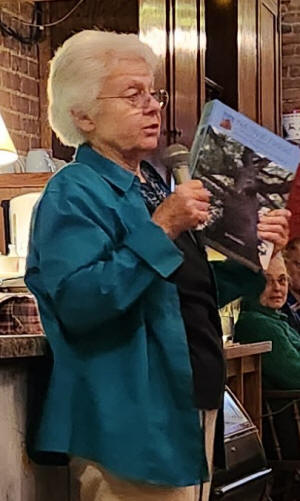
Gillette Ransom of the Elkhart Historical Society
introduced Sternberg.
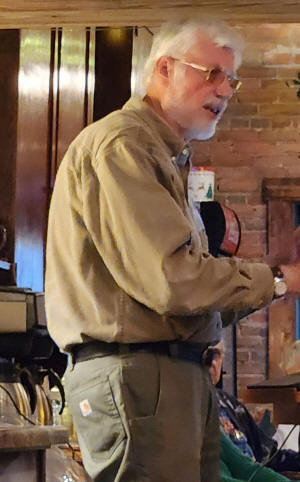
Sternberg owns the Starhill Forest Arboretum and has
written three tree books with his most recent being Native Trees of
North America from the Rockies to the Atlantic.
As Sternberg began his lecture, he said that trees affected by
emerald ash borers (EAB) generally die. There are few natural
predators of ash borers currently present in North America. When it
comes to emerald ash borers, black ash and green ash trees are
especially affected because the borers love them and white ash is
not far behind.
The blue ash tree is not closely related to green and black ash
because blue ash has a different metabolic and structural system.
Sternberg says that is a point in its favor. Blue ash is the main
species on Elkhart Hill and there are several very old blue ash
trees at the Elkhart nature preserve which have not been affected by
ash borers.

Sternberg showed photos of various ash trees. The
markings show the EAB infestation. If the problem is caught early,
these trees can be saved. Looking at the condition and size of the
growth from year to year is important. If the growth has slowed,
Sternberg said you better do something soon if you desire to save
the tree.
Early on, Barney traps (so-called because of their purple color) on
trees were used to track the spread of the invading insect. The
traps were something that Sternberg says won’t kill any significant
number of ash borers but can confirm their presence.

When looking at ash trees, Sternberg said shorter
annual twig growth, branch die-back and “D” shaped holes indicate
problems. This creates a bleaching, a pale colored appearance of the
bark in these areas. Woodpeckers can hear EAB munching on the trees
and will remove outer bark in an attempt to get at the larvae.
Sternberg said that alone does not solve the problem but gives us
one piece of the puzzle.
Where ash tree bark has already sloughed off, back and forth
squiggles tracks on the trunk show where emerald ash borers have
taken out the tissue of the tree. Sternberg said the tree is
basically dead by that point.
Questions Sternberg said you should ask are do you want to save the
tree? Is it worth saving? How large is it? Will you commit to
treating the tree for the foreseeable future either annually or
periodically?
If you decide to treat the tree Sternberg said is important to know
that the cost of treatment versus removal of the tree is about
equal.
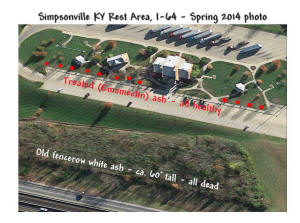
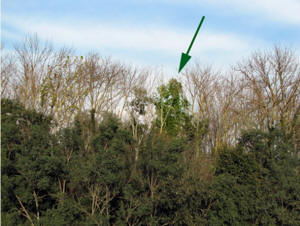
Along with many others, Sternberg has been working to
save ash trees. Some years ago, while he was driving through
Kentucky, Sternberg found an old highway right-of-way full of dead
white ash trees. But there was one survivor tree, which can be
useful for resistance breeding. A nearby rest area had many trees
that were being treated and all had survived.
Information from Michigan, Ohio and Kentucky, where blue ash is much
more common than it is here in Illinois, suggests that some of these
trees might be able to survive the emerald ash borer.

What Sternberg has found is that in the bluegrass
country of Kentucky, where limestone soils are well suited to blue
ash, observations have found that roughly 40 percent of the trees
that had been healthy when the borer arrived were still alive as the
pest population began to crash after about 10 to 12 years due to
loss of their food source.
The goal for Elkhart Hill was to bring as many of the ancient trees
there as possible into that 40% category with a one-time treatment
funded by private donations. In a three-week media blitz, Sternberg
said “we found so many generous people who agreed with that goal
that we were able to raise $14,000.” They realized no one in the
country had tried to do a media blitz like this one to help with the
problem.

Here is the story:
In April of 2021 on Elkhart Hill someone inspected the nature
preserve with Sternberg and they found a couple of dead ash trees
along the exposed edge of the area. They were not leafing out, but
many others were. The goal established for Elkhart hill was to
reinforce as many ancient trees as possible to preserve them until
biological controls could take over.
May 23, 2021, Sternberg and others began doing an Elkhart tree
inventory. He said they could do a certain number of inches in
diameter based upon the amount of money they had raised and were
looking at how many trees there were and how big they were. The
group wanted to save some of the best trees, the medium sized trees
still in good shape, and ones that had room to grow. They also
wanted to have some un-treated control trees to see if they also
would survive. After an initial walk through, the group started
measuring and marking trees, compared notes, and added GPS locations
and photos to find them later.
Sternberg said they had to get permissions and regulations from
Elkhart Hill Grove Nature Preserve (a private owner) and the
Illinois Nature Preserve Commission to comply with nature
preservation policies.

To treat trees Sternberg said they used Emamectin
Benzoate, which cost more than $500 a bottle. On June 16 and 17,
2021, treatment began with injecting thirty-two big blue ash trees.
They also arranged for eager adjacent landowners to have their own
trees treated.
On May 21, 2022, there was an Elkhart hill lightning strike at the
end of a stormy research tour. Sternberg said it was less than 100
feet from where he was standing, shook the ground, and created a
deafening sound and blinding light. At that point they left the
grove of trees for safety reasons. In October 2022 Sternberg and
others went back and found the two ash trees that had been struck by
lightning. They were blown apart, but one was still sprouting.
In fall of 2021, Sternberg and others began to gather
seed to grow seedlings and establish a new cohort (a successive
generation) of trees at the Elkhart nature preserve. Sternberg said
the team gathered local provenance seeds from female trees in
Elkhart. Some of the blue ash trees on Elkhart Hill are old enough
to predate the Revolutionary War. [to top of second
column] |

Next, they had them propagated (which is not easy) at
a commercial plant nursery in Missouri and grew them into small
seedlings for planting in the nature preserve in spring of 2023.
Donations were collected to raise money for the new trees and
several volunteers helped with the planting.
All of it was done with permission and assistance
from landowners and participation by the Illinois Nature Preserves
Commission.
Sternberg said they started with only thirty-two small trees grown
from local provenance, but if those trees mature, they will create a
new generation of this rare forest species.
When working on a nature preserve Sternberg said you
do not want to mix with the genetics of the preserve because it
contaminates what is already there.
When planting the trees in the preserve, they created open sky for
the seedlings by removing some existing groups of surplus sugar
maples. Deer resistant barriers were built using twigs and branches
from the downed maples on site, so no foreign wood or metal was
introduced to the preserve and no plantings from other areas were
brought in.
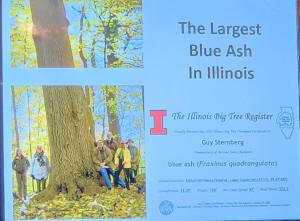
Elkhart Hill was also found to have had the largest
Blue Ash (fraxinus quadrangulata) in Illinois, making it the new
state champion for this species on the Illinois Big Tree Register.
To do tree breeding for future resistance Sternberg says you should
harvest seeds and scions from survivor trees of any affected ash
species for future resistance breeding.
The National Ash Tree Seed Collection Initiative is one organization
trying to collect trees for preservation. A brochure they have put
out says: “America is losing its ash trees at an alarming rate. An
invasive species, the emerald ash borer, has already destroyed
millions of ash trees.”

Because of that, “the loss of all of America’s ash
trees is a real possibility. An effort is underway to gather seed
from populations of native ash tree species nationwide.”
The initiative is asking people to assist in the effort by
collecting ash tree seeds and sending them to the Rose Lake Plant
Materials Center in East Lansing, Michigan.
When collecting seeds, the National Ash Tree Seed Collection
Initiative says to collect at least 500 seeds from each population
and check that seeds are filled. When mature the “seed is typically
brown to tan in color and separates easily from the tree.”
Once you have collected seeds, they should be put in a cloth or
paper bag and stored in cool, dry conditions until you are ready to
ship them. Do not put them in a plastic bag.
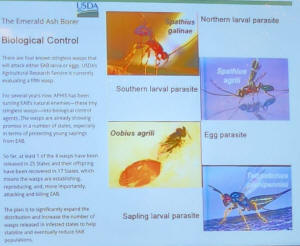
Though emerald ash borers continue to be a problem
Sternberg says they're hoping to have biological controls. The USDA
says, “there are four known stingless wasps from the emerald ash
borer’s native countries that will attack either EAB larva or eggs.”
The USDA Agricultural Research Center is currently evaluating a
fifth wasp.”
In an article on Biological Control, it says, “for several years
now, APHIS has been turning EAB’s natural enemies—these tiny
stingless wasps—into biological control agents. The wasps are
already showing promise in a number of states, especially in terms
of protecting young saplings from EAB.”
At this point, at least one of the four stingless wasps has been
released in 25 (infested) states. The offspring of these wasps have
been recovered in 17 states. The USDA says it shows “the wasps are
establishing, reproducing, and, more importantly, attacking and
killing EAB.” Additional good news for central Illinois is that a
wasp release has just been approved for public land in the Lincoln
area this year!
The plan is “significantly expand the distribution and increase the
number of wasps released in infested states to help stabilize and
eventually reduce EAB populations.”
As Sternberg says, we need to find ways to preserve what we do have.
In finishing his talk, Sternberg expressed thanks to all the people
made it possible.
One question was about treatments such as drenching a tree’s base
and why it is not effective on large trees.
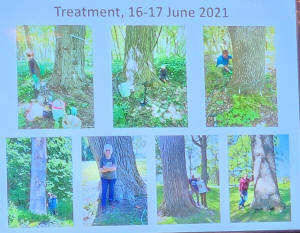
The problem is uptake and longevity. Sternberg said
if you are mixing up a soil drench to pour around the base of a tree
to let roots absorb, you are counting on the roots absorbing enough
to go up through the entire tree and out to the leaves. You are
counting on that happening at a time when the beetles are starting
to reproduce.
When using the basal drench system Sternberg said that must be done
every year and he would only recommend it for small trees. Larger
trees cannot absorb enough of the insecticide to reach all of the
way up the tree. In the next year, the treatment would have to be
done again.

Sternberg said mechanized infusion treatments with
Emamectin chemicals kill what larvae is in the entire tree. The
process is expensive and invasive but it can last for up to three
years because the chemical goes straight through the tree and acts
both as an insecticide and a deterent.
With the parasitic wasps someone asked how hopeful he was that they
would begin to make a dent in the problem. She wanted to know the
long range prognosis for using these wasps.
For a while, Sternberg said we will need to keep treating other ash
trees to get them past the surge of the emerald ash borer. Sternberg
said people need to continue to protect trees. As wasps kill borers
and the wasps reproduce, it will create a balance so there are not
as many borers around that will overwhelm a tree. Hopefully
woodpeckers will continue to adapt to feeding on the larvae and
other controls will increase as well.

When it comes to the National Seed Collection
initiative someone asked whether it applies to just to blue ash or
all ash trees. Sternberg said the collection initiative applies to
all native ash species.
Sternberg was also asked when the ash tree seeds mature. He replied
the seeds mature in early fall.
A final question was about the growth rates of ash trees.
Sternberg said that if healthy they can grow a foot or more each
year.
The next Elkhart Historical Society dinner lecture will be held
Friday, June 23 at 5:00 p.m. at the Wildhare Café in Elkhart.
Reservations can be picked up at the café and must be turned in by
June 16.
The speaker will be Professor Tony Rothering of Lincoln Land
Community College. Rothering is an official bird bander. Recently,
he was in Elkhart and was able to catch and release 120 different
birds after banding, measuring and recording them. Rothering will
explain what is going on with our climate and what it is doing to
migration patterns we have been able to observe through the years.
Ransom said Elkhart is an oasis for migrating birds.
[Angela Reiners]
Related information:
Guy Sternberg
www.StarhillForest.com
Rose Lake Plant Materials Center
USDA-NRCS 7472 Stoll Road
East Lansing, Michigan. 48823
Telephone: 517-641-6330
Email: john.lief@mi.usda.gov
(If possible, email Lief after sending seeds)
 |